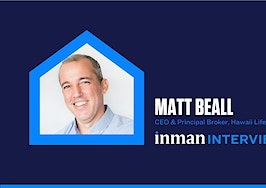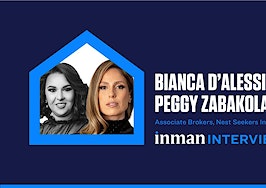In the third quarter of 2019, American homeowners experienced a 4.8 percent increase in their home equity, which translated to a whopping collective gain of $428 billion. However, homeowners are having a difficult time accessing that cash; CoreLogic estimates homeowners were able to access only $54 billion.
After years in capital management, Patch Homes co-founder Sahil Gupta saw an opportunity to use his knowledge in a burgeoning alternative financing industry that helps homeowners who don’t qualify for traditional home equity solutions by providing cash in exchange for fractional share in a home’s value.
After securing $5 million in series A funding in September, it seems Patch Homes and its other counterparts that have received equally as impressive funding aren’t going anywhere soon as Americans are looking for options that take a more holistic view of their financial and personal lives.
Before hitting the Inman Connect stage in January, Gupta sat down with Inman to talk about Patch Homes and how the fin-tech and banking industries can better serve the homeowner of today.
Inman: Before coming to the real estate industry, you spent 12 years in capital management. How did those experiences lead you to create Patch Homes?
Gupta: I started my career on Wall Street working for Mellon Capital on the asset management side. I spent a few years there helping manage money for large institutions, pensions and endowments. Having done that for a couple of years, I was one of the first employees at a company called Motif Investing, which was a fin-tech startup backed by Goldman Sachs, JP Morgan and a number of VCs.
At Motif, I was their director of investment products and strategy. I helped create platform their for retail and institutional investors to invest in the stock market, and what we saw there is that a lot of investors and consumers are looking for new and innovative, alternative ideas for their financial needs.
Through those five years, I learned a lot about what investors cared about, and there was a bigger theme there around consumers. A lot of consumers want to invest. They want to invest for their retirement, and they want to invest for their life plans, but they don’t have a lot of cash flow, and the primary reason for that is that a majority of Americans have much of their net worth tied to the value of their home.
So you end up in this situation where more and more consumers today are asset rich because of the value of their home but are cash flow sensitive. That puts them in this situation where their income is not enough to sustain homeownership any more, and that creates a big challenge for consumers. That’s where Patch Homes come in.
We’ve written about Patch before, but for those who are unfamiliar, could you explain exactly how your company solves this ‘asset-rich, cash-poor’ problem?
At Patch Homes, what we enable people to do who are asset rich and cash flow-sensitive, we enable them to get liquidity for their home [up to $250,000], which is their most prized asset, without a monthly payment, without an interest rate for up to 10 years.
So we invest in people’s homes, and in exchange, Patch gets to share in a minority portion of the future upside or downside of the home value. The benefit of this structure is that it creates a partnership between Patch and homeowners.
As the value of the home goes up or down, Patch shares in a portion of the upside and the downside. This is something that really empowers people because it allows them to get rid of monthly payments, it allows them to improve their credit score, it allows them to invest in home improvements and all of the things they’re looking to do but are unable to do with traditional, debt-based solutions.
There are a number of other companies that are offering solutions similar to Patch and it seems like there’s a consistent stream of new options coming out. What’s the catalyst behind the rise of all these alternative financial models?
I think a big part of it is the consumer demand out there. At the end of the day, what we’re seeing in the market is homeowners are struggling to make monthly payments while they’re collectively holding trillions of dollars in home equity. We believe that’s a macro trend happening in the market.
The other aspect is that banks and other lenders like Bank of America and Chase, who historically have provided home equity loans, take a very manual view of who gets qualified and approved for these HELOCs.
What this means is that this very narrow view often leaves out small business owners and other consumers who have financial lives that have been historically considered non-traditional. That doesn’t allow those homeowners access to affordable credit solutions.
We take a holistic view of the financial situation of the homeowners we partner with, and this is the fundamental reason why Patch exists — we want to provide people access to credit while taking into account their full financial profile including their savings and income and not just focusing on their credit score, which is what most of the banks are doing.
As the gig economy strengthens, do you think banks will adjust their strategy and begin offering similar alternative financing models?
I think the biggest challenge banks have is, historically, they’ve only seemed to credit FICO scores as the primary base of measuring risk. The reality is that FICO and credit were a really good system in an economy where everyone had a stable job and they stayed at the same job and in the same house for 10 to 15 years.
What’s happened over the past 15 years in the U.S. and global economy, in the sharing economy and the gig economy, there has been a bigger transition today from being W-2 employed to a 1099. The current model of analyzing risk for banks is not suited for this structure, and the capital structure supporting banking systems offering these loans are not taking a holistic view of consumers.
That’s how Patch, and other companies like us, are able to differentiate ourselves in our ability to holistically analyze risk. At Patch, we take a combination of internal risk models that use machine learning and heuristics to model and better identify price and manage risk at a more holistic level compared to a traditional, FICO-based system.
Where do you see the future of this industry going? Where do you see Patch going?
I think for us, our business model is based on the belief that homeowners are partnering with Patch for long-term investment. Imagine the day you buy your house — that day is teeming with promise, and it’s the start of a new journey. For most homeowners, especially first-time homeowners, the moment you put your key into the door and enter it, that’s your home, and that becomes your safe space.
Every other broker or company that helped you get that home stays outside of the door because they view homeowners as a transaction. For most companies, the story and relationship with the customer ends right then and there.
Patch, as a company, was created for the moment you enter the house. The average American homeowner stays in their house for 7 to 10 years, and that homeownership [journey] isn’t always ups, right? There is a constant barrage of decisions people have to make about their families and their finances, and what they need in those moments is a trusted partner and home advisor.
Patch is a home advisor. It’s built for all the moments that will happen over those 10 years, and we want to support homeowners through each step.
Homeowners are now asking for other products — products to refinance their homes, to help with mortgage payments, to help with the costs of moving and selling the home, and all of these things become opportunities for Patch to add value to the customers and become a trusted partner. So, that’s what’s next for us.

Create your own success story at Inman Connect New York, Jan. 28-31, where over 4,000 industry professionals gather to forge new relationships, share tactical takeaways and discover the latest technology to boost their bottom line.
Thinking of bringing your team? There are special onsite perks and discounts when you buy tickets together. Contact us to find out more.













